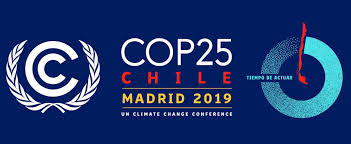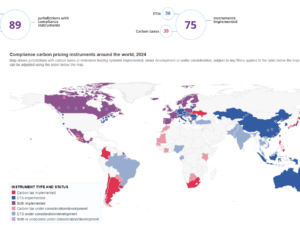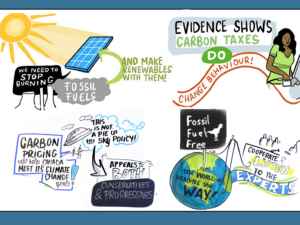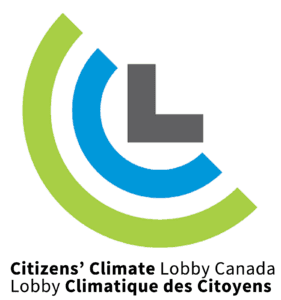By Cathy Orlando, International Outreach Manager, Citizens’ Climate Lobby I have just returned from the 25th Conference of the Parties (COP) under the United Nations Framework Convention on Climate Change (UNFCCC) in Madrid, Spain (COP 25). The world is still on track for blowing past the safe upper limits for global heating, the rule book for Article 6 of the Paris Agreement was not finalized and the loss and damage mechanisms for atonement of western civilization’s obscene fossil fuel emissions seem even further out of reach. Yet, I am hopeful because I felt the power of the people at this COP. In 2009, I followed closely the COP 15 negotiations in Copenhagen from the comfort of my home town Sudbury, ON. I knew instinctively it was going to fail because it did not have the grassroots’ support it needed. This is my third COP. I started attending the COPs two years ago. Something was palpably different at this COP. The explosion of the Fridays For Future and Extinction Rebellion movements across the planet over the past year was felt. Consequently, I have decided to focus on two Fridays For Future youth that attended COP25. Vanessa Nakate – Uganda I was fortunate to attend a session at COP25 where Vanessa was a panelist. The session was about bringing youth and scientists together. Key to Greta Thunberg’s success, which makes her impermeable to criticism from the climate destroyers, is that she is neither policy prescriptive nor partisan. Greta and the FFF movement’s key message are Unite Behind the Science, which was the title of the event I attended. During the Q&A session, I was lucky enough to make a statement which included a hello and admiration from my daughter Sophia to Vanessa. Vanessa knew who I was talking about. When the session was over, Vanessa came down off the stage and we hugged, we pulled back and looked at each other. We both had tears in our eyes, and I said, “There are no need for words,” and we hugged again. It simply was a profound moment of love, that still gives me tears of joy and hope as I write this story. To find out more about Vanessa please watch her Democracy Now interview. On Twitter follow Vanessa and Youth For Future Africa the organization she founded. Jorge Martinez – Mexico One of the biggest standout moments for carbon pricing for me at the COP was when Jorge secured us a meeting with two of the Mexican delegates. We discussed the Mexican carbon pricing system and how it was like Canada’s carbon pricing backstop policy with a fuel tax for consumers and a separate system for emissions-intensive and trade-exposed industries. We discussed the various revenue recycling systems. Finally, we knew that we were successful when they asked for technical papers on what we had discussed. Watch and listen to Jorge’s speech at the People’s Plenary. Postscript: 2020 Vision on Carbon Pricing My personal journey with carbon pricing and climate change began at COP 15. Suffering from climate trauma, I took a month off of work in February 2010 and it was then I determined I should focus solely on carbon pricing. In June 2010, I met Marshall Saunders, the founder of Citizens’ Climate Lobby and was forever cured of climate trauma. Ten years later the landscape is radically different. Ten years later, 46 national governments either price carbon pollution or will be implementing carbon pricing. As well, 96 countries have carbon pricing in their Nationally Determined Contributions (NDCs). At COP 25 the Carbon Pricing Leadership Coalition conducted two dialogues with real world examples that showed that businesses, sub-national governments and countries that price carbon pollution have the advantage and that a just transition and carbon pricing can go hand in hand. As well, the World Bank launched the Partnership for Market Implementation which will assist countries in the Global South in either improving their current carbon pricing or implementing carbon pricing. In conclusion, sooner or later, the USA government will join the coalition of the willing. Meanwhile, behind the scenes, CCL leaders have brought messages of carbon pricing to our governments in over 50 countries around the world. And therein lies the hope – the hope lies within the people such as Jorge, Vanessa and the countless heroes in the climate movement. ———– *On November 2, 2018, my then 11-year-old daughter Sophia Mathur began striking with Fridays For Future (FFF). As part of her activism we created a Twitter account for Sophia. It was hacked in May 2019 and ultimately deleted by Twitter due to inane rules. We re-established her account in July. I monitor Sophia’s social media activities quite closely. Thus, by default, I have been following the many incredible sagas of the FFF youth across this planet, including Vanessa.BLOG: Heroes and Hope at COP 25 in Madrid
One of the very first Fridays For Future strikers on the continent of Africa and the first in Uganda is Vanessa Nakate. Week after week since early 2019 my daughter Sophia* and I have been following Vanessa. Her Twitter feed highlights the devastating climate impacts in Uganda, the destruction of the Congo Rainforest and the complex struggles of FFF striking in Uganda. In this session Vanessa proved herself to be an extremely effective messenger and bridge builder. Her leadership and communication skills defy her years. Vanessa’s youth gives her the moral authority to demand climate action now. What struck me most was the additional layer she brought to the Unite Behind the Science message to include traditional knowledge of the farmers in her country who are seeing firsthand the impacts of the climate crisis.
In this session Vanessa proved herself to be an extremely effective messenger and bridge builder. Her leadership and communication skills defy her years. Vanessa’s youth gives her the moral authority to demand climate action now. What struck me most was the additional layer she brought to the Unite Behind the Science message to include traditional knowledge of the farmers in her country who are seeing firsthand the impacts of the climate crisis.
For almost 30 years Mexico, Canada and the USA have been trading partners previously under NAFTA and now under CUSMA. Thus, it is critical that our three countries harmonize our responses to the climate emergency. One of our CCL leaders in Mexico, Jorge Martinez. He is under 30 years old. In addition to being part of CCL, he is also involved in Fridays For Future Mexico and is a Mexican representative of YOUNGO, which is one of the official constituencies at the UNFCCC. Jorge was the YOUNGO spokesperson at the People’s Plenary which was an officially sanctioned Civil Society action on Saturday, December 14, 2019 in the halls of the COP25 in Madrid.
One of our CCL leaders in Mexico, Jorge Martinez. He is under 30 years old. In addition to being part of CCL, he is also involved in Fridays For Future Mexico and is a Mexican representative of YOUNGO, which is one of the official constituencies at the UNFCCC. Jorge was the YOUNGO spokesperson at the People’s Plenary which was an officially sanctioned Civil Society action on Saturday, December 14, 2019 in the halls of the COP25 in Madrid.
Read CCL Canada’s 2019 Open Letter to the CUSMA Initial Environmental Assessment
In 2009, at COP 15, in Copenhagen the Kyoto Protocol began to fall apart. The Protocol was linked to the UNFCCC. It was adopted in Kyoto, Japan on December 11, 1997, and became international law on February 16, 2005. The USA never ratified it and Canada was the only country to withdraw from it.
BLOG: Heroes and Hope at COP 25 in Madrid
Home » CCL Canada News » BLOG: Heroes and Hope at COP 25 in Madrid












